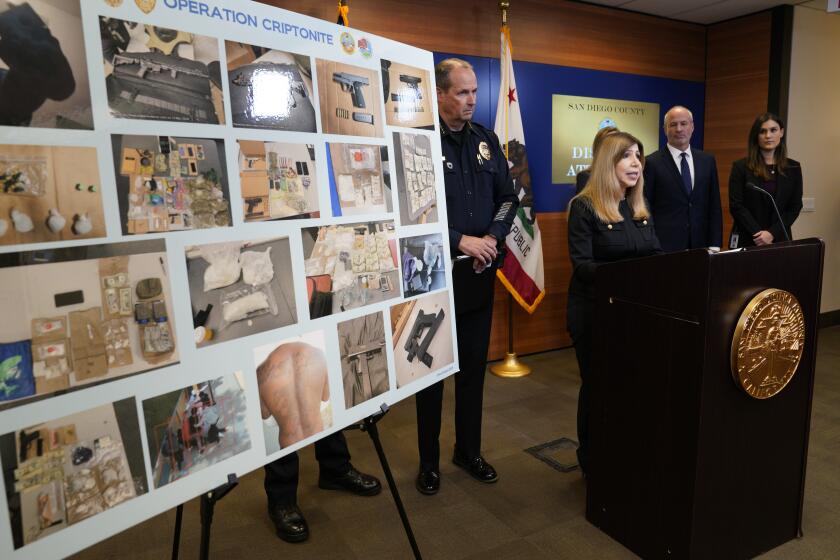San Diego mayor, chief and police reform advocate talk policing during forum

The forum was held in response to a study that found that people of color — especially Black people — are stopped, searched and subjected to force more often than White people
San Diego police Chief David Nisleit and Mayor Todd Gloria discussed a wide range of policing issues Tuesday in light of a recent study that found racial disparities in pedestrian stops, vehicle stops and uses of force by officers.
The long-awaited study, released last week, showed that people of color — especially Black people — are stopped, searched and subjected to force more often than White people. Representatives with the Center for Policing Equity, which conducted the study, shared key findings with the public during a virtual forum Tuesday.
The report is the latest study to show racial disparities in policing locally. A Union-Tribune analysis of nearly 500,000 stops by San Diego police officers and county sheriff’s deputies earlier this year found similar racial disparities.
During the forum, Gloria and Nisleit were joined by Bishop Cornelius Bowser, a police reform advocate who said the racial disparities represent a systemic problem within the San Diego Police Department.
“It doesn’t meant that officers are racist,” Bowser said. Instead, he explained, the issue is racial bias that “officers don’t think about.”
How officers police Black communities versus White communities is embedded in the culture of policing, he said.
“You see a Black man and think criminal,” he said. “I believe when police officers are out there in patrol they have to reimagine policing.
“All we’re asking for is fair treatment,” he added.
Gloria highlighted a set of policing reform proposals he announced in April, saying he believes some will address racial disparities in policing. The mayor pointed to proposals that recommend “(exploring) policies that would limit the use of pretextual stops and consent searches.”
Nisleit touched on recent reforms and noted that the Police Department intends to update its policy on consent searches. The revisions would require officers to notify individuals they stop of their right to refuse a search and require officers to get consent to a search in writing or on body-worn camera video. Speaking of the proposed changes, Nisleit said the department wants to address the needs of the community without stripping officers of what he described as a “good tool.”
He also said that while he holds officers accountable, he welcomed the oversight of the city’s new Commission on Police Practices. He said he hopes for impartial and “true” investigations by the volunteer-led commission.
Bowser said that although he supports the commission, he believes it wasn’t given enough power. He said the commission should be able to discipline officers in the event that department brass does not.
Nisleit said he hopes for “balanced reforms” moving forward and looks forward to conversations with the community. “The community has a role,” he said. “I do want to hear from the community.”
The recent study, which the Police Department commissioned at no cost in 2019, looked at data on pedestrian stops, traffic stops and use of force between 2016 and into 2020. The study showed that while 6 percent of San Diegans are Black, they account for nearly 23 percent of all pedestrian stops.
According to the study, Asians and Latinos were searched more often than White people during pedestrian stops, even though Asians were found with contraband less often than Whites who were searched.
During traffic stops, Blacks and Latinos were more than twice as likely to be searched than White people, even though Latinos were found with contraband less often than Whites who were searched.
According to the analysis, not one patrol officer stopped Black people at rates that were lower than the proportion of Black residents in an officer’s patrol area. However, 17 percent of patrol officers stopped White people at rates that were lower than their share of the population in their patrol areas. More than 60 percent of patrol officers stopped Latinos at rates that were lower than the proportion of Latino residents in their patrol areas.
The disparities remained even after researchers used a statistical technique called a regression analysis, which accounts for factors such as neighborhood demographics, poverty and crime rates. Even after accounting for these factors, the analysis showed that Black pedestrians were stopped 4.2 times as often and were subjected to force nearly 5 times more often than White people.
The findings will be presented to the City Council June 29. A virtual forum for youth will be held at 5:30 p.m. June 30. To RSVP, visit sandiego.gov/CPEreport.
The latest news, as soon as it breaks.
Get our email alerts straight to your inbox.
You may occasionally receive promotional content from the San Diego Union-Tribune.



